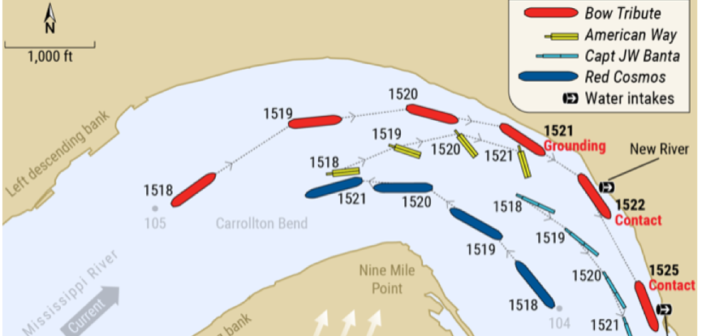The National Transportation Safety Board has just released its report about an accident on the lower Mississippi River involving a 599-foot tanker and a 70-foot tow boat with two barges that has some lessons for us all. The NTSB said the accident was probably caused by the tanker captain’s decision to pass the tow and its barges in a large bend in the river, with lots of other traffic around and a strong following current, as well as poor communications between the captains of both boats.
The accident occurred in the afternoon of March 16, 2021, near mile 104 of the lower Mississippi. The steel-hulled tanker, the Bow Tribute, with 29 people on board, was heading downriver in high water with a 3.5-knot following current in 10-mile visibility. The wind was from the south-southwest at 15 knots, with gusts to 24 knots.
About two miles ahead, also going downstream, was the American Way tow boat, pushing two empty barges breasted side-by-side so that they presented a tow 368-feet long and 108 feet wide. Four people were on board. The tow was going 7.8 knots; the tanker about twice that speed.
At 1502, the pilot on the tanker radioed the tow, then 1.7 miles ahead, saying “It looks like we’re going to meet.” He said he would pass the tow at Nine Mile Point, a bend in the river that is 1,800 feet wide at its narrowest point (see the diagram at top). He asked if the tow could either speed up or slow down. “We can speed up a bit,” the pilot of the tow replied.
Three minutes later, the tow pilot radioed back to the tanker, “What side did you say you wanted to overtake me?” The tanker pilot replied, “I can overtake you on the two, if that’s alright with you,” meaning he would pass the tow on the tanker’s starboard side. The tow pilot confirmed, “Alright, see you on the two.”
Meanwhile, more traffic was approaching the bend in the river. The Capt JW Banta was also downbound, loaded with two barges, running at 8.9 knots. And the Red Cosmos, a 653-foot bulk carrier, was nearing the bend, but it was traveling upbound.
At 1511, the NTSB report said, the pilot on the tanker told an observer, “The American Way needs to slow down,” adding a minute later, “I don’t like to do this, but we got to. I have no choice.”

At 1519, the tanker (pictured above) running at 15 knots, was just 0.15 miles behind the tow in the bend in the river, but the tow started sliding sideways, toward the left descending bank, basically in front of the passing tanker. The tanker pilot radioed, “You gonna make it, huh?” There was no response from the tow. A second later, the tanker pilot called again, asking “You gonna be alright?” The tow pilot then replied, saying he was “trying to get up.”
Half a minute later the tanker pilot, seeing the tow continuing to slide in the bend ahead of him, told the second officer to have the anchors ready to deploy. He then called the tow, saying “You gotta drive that thing man,” but there was no reply, or any further communications, from the tow.
Then, with the starboard bow of the tanker just 130 feet away from the stern of the tow, the pilot of the tanker issued a series of orders, announcing that the tanker was “colliding at Nine Mile,” meaning he would hit the side of the river, and ordered the engine full astern.
The tanker could not turn to starboard without hitting the tow, and it hit the bank on its port side. The stern hit the fender system on the bank, rising out of the water with the tanker traveling at 10.3 knots. It continued along the left descending bank with 21 knots of wind on its starboard side. A second later the port side of the tanker hit a spud barge protecting a water intake for the city of New Orleans. The barge broke free from its moorings and drifted down the river.
The tanker let go of its starboard anchor but the boat hit another protective spud barge and stopped.
No one was injured in the accident. But the damages included $986,400 to the tanker and $926,100 to the protective fender systems and spud barges along the river.
In the conclusion of its report, the NTSB said, “The probable cause of the grounding of the tanker Bow Tribute and its subsequent contact with the river intake fender systems was the pilot’s decision to overtake a tow in a large river bend occupied by multiple vessels during high river conditions with a strong following current. Contributing to the grounding was the ineffective communication between the pilot of the Bow Tribute and the pilot of the towing vessel American Way regarding where the overtaking maneuver would occur.” Read more:
https://www.ntsb.gov/news/press-releases/Pages/NR20220414.aspx




